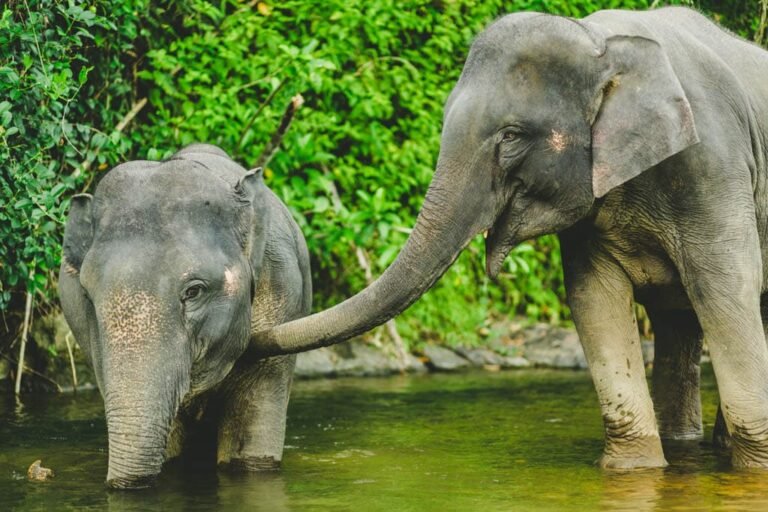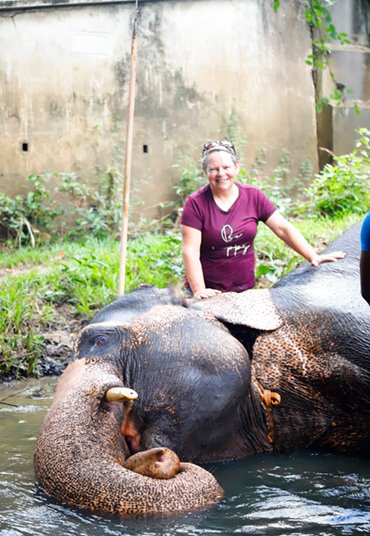Human-Elephant Conflict in Sri Lanka
Human-Elephant Conflict in Sri Lanka:
Root Causes, Consequences, and Solutions

Introduction: Human-elephant conflict (HEC) is an ongoing issue in Sri Lanka, where the increasing overlap between human populations and elephant habitats has led to a tragic cycle of violence, property damage, and loss of life on both sides. With an estimated 7,000 wild elephants living in Sri Lanka, the challenges of balancing conservation with human development are increasingly becoming a priority for policymakers, communities, and conservationists. In this blog post, we’ll explore the root causes, consequences, and potential solutions to HEC, as well as how cultural and economic factors shape the issue.
Root Causes of Human-Elephant Conflict
1. Habitat Loss and Fragmentation Sri Lanka’s rapid agricultural expansion and urbanization have led to significant habitat loss and fragmentation for elephants. Large swathes of forest that were once their natural habitat have been cleared for farming and development, leaving elephants with less space to roam. This disruption makes it difficult for them to access food and water sources, forcing them to venture into human settlements in search of resources. The encroachment of cities, roads, and infrastructure only compounds this problem, creating more points of conflict.
2. Limited Space to Roam Elephants are large, migratory animals with a need for vast territories to find food, water, and mates. With limited land available for these magnificent creatures, they are increasingly confined to smaller and more fragmented pockets of wilderness. These limited spaces push elephants into human-dominated areas like farms, villages, and even towns. This overlap often leads to conflict, particularly during the dry season when natural food sources are scarce, and elephants wander closer to agricultural lands in search of food.
3. Changes in Land Use Over the years, the land that elephants once roamed freely has been repurposed for agriculture, industrial development, and infrastructure projects. For example, large-scale plantations of crops like tea, rubber, and coconut have spread across the island, further shrinking elephant habitats. As these land-use patterns continue to change, elephants are being forced to alter their migration routes, leading them to travel through human-populated areas that were previously off-limits.
Consequences of Human-Elephant Conflict
1. Human Casualties and Property Damage One of the most immediate consequences of HEC is the loss of human lives and property. Elephants, when confronted with barriers or perceived threats, can become aggressive, often causing injury or death to farmers, villagers, or travelers. In addition, elephants are known to damage crops, homes, and vehicles in their search for food, leading to significant economic loss for local communities.
2. Elephant Fatalities The conflict is not one-sided. Elephants are often victims of retaliation, either through direct harm by farmers or through vehicle collisions on roads that cut through their habitats. In some instances, elephants are poisoned, shot, or trapped, leading to a decline in the elephant population. The loss of these majestic creatures is not only a tragedy for conservation but also a loss of cultural and natural heritage for Sri Lanka.
3. Economic and Social Costs The human-elephant conflict has a far-reaching economic and social impact. The destruction of crops and loss of livestock severely affects rural communities, whose livelihoods often depend on agriculture. In addition to the economic toll, the social fabric of affected communities can be strained, as farmers and local populations grow frustrated with the persistent threat of elephants destroying their crops or property. The trauma caused by elephant attacks further exacerbates the emotional and psychological toll on communities.
Cultural and Economic Significance of Elephants
1. Elephants in Sri Lankan Culture In Sri Lanka, elephants hold immense cultural and religious significance. Revered in Buddhist traditions, they are symbols of strength, wisdom, and peace. Elephants are featured in temple festivals and processions, and their importance is woven deeply into the fabric of Sri Lankan life. This cultural reverence adds emotional complexity to the conflict, as communities face the dilemma of respecting and protecting elephants while also safeguarding their own livelihoods.
2. The Role of Elephants in Tourism Sri Lanka’s tourism industry also relies heavily on elephants, both in wildlife tourism and in religious events. Tourists flock to the island to experience safaris in national parks, where they can observe elephants in their natural habitats. The negative impact of HEC on elephant populations threatens this vital tourism sector, as decreasing numbers of elephants may reduce the country’s appeal as a wildlife destination.
Mitigation Efforts to Address Human-Elephant Conflict
1. Fencing and Barriers To protect crops and human settlements from elephants, some areas have introduced fencing and barriers. However, while these solutions can provide temporary relief, they are often ineffective in the long term. Elephants are capable of breaking through or finding ways around barriers, which means that fencing can only offer partial protection.
2. Early Warning Systems and Elephant Corridors In an effort to minimize human-elephant conflict, some regions have introduced early warning systems that alert communities about elephant movements. These systems, often linked to local wildlife monitoring, can help farmers and villagers prepare and avoid potential confrontations. Additionally, establishing elephant corridors—designated safe paths that elephants can follow to migrate between habitats—has been seen as a promising solution to reduce conflict by allowing elephants to move without entering human-populated areas.
3. Community-Based Conservation and Education Programs Community involvement plays a critical role in mitigating HEC. Conservation programs that educate local communities on how to coexist with elephants, including strategies to protect crops or handle elephant encounters, have been successful in some areas. By fostering understanding and encouraging collaboration between farmers, wildlife authorities, and conservationists, these programs have helped reduce incidents of conflict and promote long-term sustainable solutions.
4. Government Policies and Wildlife Management The Sri Lankan government has implemented policies to address HEC, including strengthening laws against poaching and improving wildlife management strategies. However, more comprehensive plans, such as land-use reforms and better enforcement of conservation areas, are needed to ensure that both elephants and humans can thrive in harmony.
Success Stories and Ongoing Challenges
1. Positive Examples of Conflict Resolution Despite the challenges, there have been success stories where human-elephant conflict has been mitigated through innovative approaches. One example is the work being done in Sri Lanka’s national parks, where efforts to connect fragmented habitats and create wildlife corridors have shown promise in reducing elephant movement into human settlements. Furthermore, some community-driven initiatives, such as the establishment of elephant-friendly farming practices, have helped to lessen the impact on both local populations and elephants.
2. Ongoing Challenges However, there is still much work to be done. The continuing loss of habitat due to urbanization and farming expansion, along with the persistence of retaliatory killings, underscores the need for more sustainable solutions. Long-term success depends on the collaboration of local communities, conservationists, and policymakers to balance the needs of both people and elephants in Sri Lanka.
Conclusion: The conflict between humans and elephants in Sri Lanka is a complex issue rooted in habitat loss, land use changes, and the growing human population. While the consequences of this conflict are severe, from loss of life to economic hardship, there is hope. Through government policies, community engagement, and innovative conservation practices, it’s possible to reduce the impact of HEC and create a future where both elephants and humans can coexist peacefully. As Sri Lanka continues to tackle these challenges, the global community can learn valuable lessons in balancing wildlife conservation with human development.
Threats Faced by Sri Lankan Elephants
Today, the greatest threat to African elephants is wildlife crime, primarily poaching for the illegal ivory trade, while the greatest threat to Asian elephants is habitat loss and the resulting human-elephant conflict. With their natural habitat decreasing, elephants often come into conflict with human populations. This conflict can result in the loss of human lives, property damage, and reactive killings of elephants.
Habitat Loss:
The most significant threat to Sri Lankan elephants is the loss of their natural habitat due to human activities like deforestation, urbanization, agriculture expansion, and infrastructure development. As their habitat shrinks, elephants are forced to enter human settlements in search of food and water, leading to conflicts with local communities.
Poaching and Illegal Wildlife Trade:
Elephants are targeted for their tusks, which are in high demand on the black market for ivory. Despite national and international efforts to control poaching, this illegal trade continues to pose a serious threat to Sri Lankan elephant populations.
Fragmentation of Populations:
Habitat fragmentation can lead to isolated elephant populations, reducing their genetic diversity and making them more vulnerable to diseases and other threats.
Climate Change:
Climate change impacts such as changing rainfall patterns, droughts, and extreme weather events can affect the availability of water and food resources for elephants.
Human Encroachment and Infrastructure Development:
Expansion of human settlements, roads, and other infrastructure projects can encroach upon elephant habitats, leading to further habitat loss and increasing the risk of accidents and conflicts between humans and elephants.
Electric Fencing:
While electric fencing is sometimes used to prevent human-elephant conflicts, improper installation or maintenance can lead to injuries or deaths of elephants.
Human Activities in Protected Areas:
Even within protected areas, illegal activities such as logging, agriculture, and settlements can negatively impact elephant populations and their habitats.
Lack of Effective Conservation Measures:
Inadequate enforcement of wildlife laws, weak conservation management, and limited resources for conservation efforts can weaken the protection of Sri Lankan elephants.
Conservation organizations, researchers, and the Sri Lankan government have been working to address these threats and implement various conservation measures to protect and conserve the country’s elephant populations. However, ongoing efforts are crucial to ensure the long- term survival of these majestic creatures in their natural environment.







